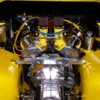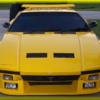Finally was able to get up to Superior Auto Engineering in Anaheim and get on their dyno.
These guys do all the tuning for Hilborn, especially for the racers.
Impressive place, they are all serious racers themselves and great to work with.
Did 4 pulls, only turning to 6K rpm since I have 2 hours on the motor. Started with 418 rwhp and tuned it to 456 rwhp on the 4th pull. The hp graph was still going straight up at 6K rpm and the dyno guy ( Joe ) said there was probably another 25-30 hp avialable if I wanted
to rev it higher.
By their calculations the motor put out 547 bhp
from the 456rwhp, which is about what I had hoped for.
I plan to put some freeway miles on it this weekend.
I also want to thank Dan Jones for his help and coupe3w for the great CHI-4V heads. Oh yes, Marlin Jack, for getting me the pilot bearing so quickly.
Most importantly, John Buckman ( jb1490) for working his butt off ( every afternoon for weeks )when nothing seemed to fit or want to go together. He didn't even know me prior, just as a memebr of the San Diego Pantera Club and yet there he was. Says alot about Pantera owners
and their generosity.
Lastly, this forum has been an amzing source of
really helpful info and I sure appreciate everyones input.
Attachments
Original Post



